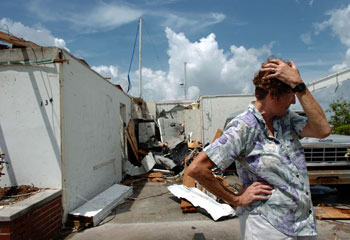 |
 | ||||||||||
Debris
September 2004
|
 |
|||||||||
|
Out of the corner of my eye, I saw a U-haul truck on top of what used to be a liquor store. The building was gone, and the scene was chaotic when I pulled over.
I climbed on someone's truck and photographed employees looking confused and distraught at the crumbled remnants of their workplace. The owner was making phone calls, or trying to. I stayed for a while and then moved on as other media members began to arrive. My goal was to make it to Punta Gorda, a small city leveled by Hurricane Charley.
The days before a hurricane seem eternal. Every night on television you track the storm and its projected path, which can vary 100 or so miles in any direction. Charley was a tropical storm that grew into a category 1 storm and then a category 2. No one expected it to be a category 4 storm. All morning on Friday, Aug. 13, the storm models had it making landfall in Tampa, some 100 miles north of Charlotte Harbor.
Our staff had been shooting storm preparations, evacuations and preparing ourselves to cover Charley all week. Our staff was ready. I was ready. I lived in Fort Lauderdale when Hurricane Andrew hit Dade County in 1992, and I had witnessed what a hurricane can do. I was prepared for damage, but I wasn't as prepared for disaster. While I've covered hurricanes before, none of them destroyed so much.
I rode out the storm in my house in Englewood, Fla., about 20 miles north of Charlotte Harbor. After about an hour of heavy rains and wind, it all just stopped. We had lost power, so we didn't know what was going on. I thought it was the eye, but my neighbor came outside and told me it was over. He had been tracking the storm on the Internet on his laptop and cellular phone. He said, "It hit Charlotte Harbor. The eye is moving inland."
I called Mike Lang, director of photography at the Sarasota Herald-Tribune, and I asked him what he wanted me to do.
"Head to Punta Gorda," he said. "See if you can get there. It was decimated by the storm."
I drove as fast as I could toward Punta Gorda. I was the only car on the road. The damage was minimal along S.R. 776 heading into Port Charlotte. As I got closer to U.S. 41 in Port Charlotte, the landscape began to change quickly. I avoided the first traffic light that was hanging near the ground, then another and another. There was no electricity; power lines were down. Entire buildings were destroyed. Businesses were gone. Entire blocks were inaccessible because of downed utility poles, power lines and trees. Looking at the destruction mile after mile, it seemed unreal. I was shocked.
From the roadblock, I walked over to a marina that was destroyed. The owner said he didn't want to be photographed, so I apologized and moved on. Then I noticed that the realty company I had driven by many times was gone; it was a pile of rubble. I began taking photos of the destruction when the owner, Thomas George, drove up to survey the damage. I started taking pictures, and then we struck up a conversation. He asked me to follow him into what remained of the building. Most everything was wet and broken, but some of his computers looked like they made it through the storm.
"I'll rebuild," he said.
After talking to him, I kept moving, asking people where there was damage. They told me a lot of the homes along Edgewater Drive were destroyed. I headed there and couldn't believe my eyes. It looked like Baghdad after the bombing. Cars were driving on lawns to avoid debris and obstacles on the road. People were outside just looking around, looking lost. I found a family on a side street whose home was decimated. Everything was soaked. There was so much destruction on the street, I could have picked any house there, but what caught my eye was a little boy playing with his lawn mower by a downed tree. He didn't seem to understand what just happened. He looked happy to be outside playing, without a care in the world. His father and mother began to show me around when I noticed the little boy's sister's look of confusion and fear as her mother held her tight. She looked like she'd seen a ghost. I had found fear and resilience in that single yard.
The following day, I was allowed to roam through Port Charlotte and just photograph. We were still figuring out what just happened. Everyone was. There was so much destruction. Some places were unrecognizable. A few days later, Cass told me, "Man, I got lost going to the high school, I got turned around and I've been there 100 times." Earlier in the week, the same thing happened to me.
The most amazing sight wasn't something I saw. It was what people were doing for each other. Neighbors helping each other climb out of the devastation. There were people from far away places helping those in need.
Everyone I photographed was very forthcoming. There were a few people who thanked me for the work I was doing. That was a first. I had never been thanked for taking pictures during a disaster.
© Armando Solares
Dispatches are brought to you by Canon. Send Canon a message of thanks. |
||||||||||
Back to September 2004 Contents |
|



